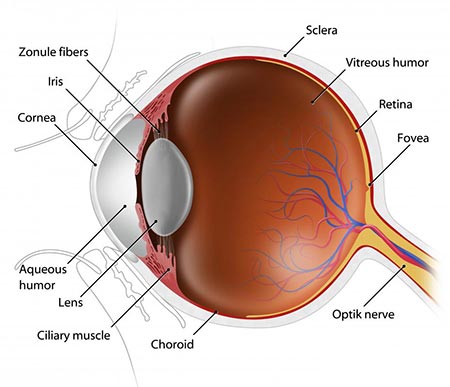Cataract surgery is generally a safe and quick procedure that involves the removal of the clouded lens inside your eye (the cataract) and its replacement with a clear artificial lens.
However, certain eye conditions can make surgery difficult, increasing the risk of complications. This means that you may have delayed healing and a prolonged recovery after surgery, or you might require another surgery to help improve results.
If you have any risk factors for complicated surgery, your surgeon will discuss these with you beforehand.
This article discusses the eye conditions that could make your surgery more difficult for the surgeon than a standard one.
Past Trauma to the Eye
Any past injury to the eye, or even to the head or face, can cause changes inside the eye that may affect vision. Even blunt blows to the eye, head, or face can indirectly cause injury inside the eye from shock waves.
The changes occurring inside the eye after injury can affect any of the structures inside the eye. This can make cataract surgery itself challenging for the surgeon and can also affect the recovery of vision after surgery. Dealing with such eyes is tricky and requires extra equipment and skill on the part of the surgeon.
It is important to always let your surgeon know if you have had any sharp or blunt injury to the eye, surrounding areas of the face, or head, so they can be prepared beforehand.
Following are the ways in which trauma to the eye can affect the results of cataract surgery:
Damage to the retina or optic nerve:
For clear vision, all structures inside the eye need to function normally. Trauma to the eye, from either a penetrating injury or blunt force, can cause scarring at the back of the eye or damage to the optic nerve. This can mean poor recovery of vision after cataract surgery.
Glaucoma:
Trauma can cause damage to the fluid drainage system inside the eye, leading to increased eye pressure and glaucoma. Glaucoma damages the optic nerve, which carries vision from the eye to the brain. In such cases, improvement in vision after surgery might be limited.
Damage to the lens:
Damage may occur to the lens and its surrounding structures, making cataract surgery itself difficult.The lens inside your eye is held in place by thread-like structures, called zonules, that connect it to the eye wall. After the cataract is removed from your eye, it is replaced by a new artificial lens, which is held in place by the same thread-like zonules.Blunt blows to the eye, head, or face can cause damage to these zonules. This can make the lens inside the eye unstable and wobbly. The lens may even be displaced from its normal position in the eye. Such conditions can make cataract surgery difficult, and additional equipment and surgery may be needed to fix the lens in place inside the eye.At times, the instability of the lens can be seen during the eye exam done before surgery, so the surgeon knows what to expect and is ready to handle any difficulties that may arise during surgery. Other times, the problem is only detected during the surgery. If your surgeon knows that you have had past trauma to the eye or its surrounding areas, they can be prepared beforehand for possible complications during surgery.
Damage to the iris:
The iris is the colored part of the eye that changes its size in response to light. This change in size controls the amount of light entering the eye. Damage to the iris results in increased sensitivity to light, as the amount of light entering the eye cannot be adjusted.After cataract surgery, you may experience increased sensitivity to light if your iris is damaged. This is because after the cataract is removed, your vision clears up and more light can enter the eye, but the damaged iris cannot control how much light enters the eye.Damage to the iris will need to be repaired as a separate procedure or in the same setting as cataract surgery to improve sensitivity to light. Additional equipment and skills are needed to perform iris repair surgery.

Pseudo-exfoliation
Pseudo-exfoliation is a genetic condition in which the zonules inside your eye are naturally weak. Zonules keep the lens in position inside the eye. If the zonules are weak, this makes the lens wobbly, and cataract surgery becomes tricky.
The weak zonules may not be able to tolerate the small forces required to remove the cataract from the eye. Also, they may not be able to hold the new lens in place inside the eye. Special devices would then be needed to provide support to the zonules, or the lens may be held in place using a different surgical technique.
Surgery in such cases takes longer, and the recovery time after surgery may be prolonged.
Additionally, in pseudo-exfoliation, the muscles of the iris (the colored part of the eye) are also weak, so the pupil (the black part of the eye) doesn’t enlarge enough during surgery. The cataract is present behind the pupil, and for safe removal of the cataract, the pupil needs to be large enough to allow the surgeon to see the cataract clearly.
Special devices are needed in such cases to make the pupil larger during surgery. These may make the pupil permanently larger. Often, the patient does not notice this change, and it may cause no symptoms. However, it may cause the eye to feel a bit uncomfortable in bright lighting. If this occurs, additional surgery may be needed to make the pupil smaller.
Very Large or Small Eyes
Complications can occur in eyes that are too small or too large. You cannot usually tell if an eye is too large or too small by just looking at it. The size of the eye is measured before surgery with machines. If you are very nearsighted, your eye may be larger than normal. If you are very shortsighted, your eye may be smaller than usual.
In eyes that are too small, the space inside the eye in which the surgeon has to work is very limited. This can mean that damage can occur to the structures inside the eye from the instruments used and the ultrasound energy needed to break up the cataract. This can cause excessive swelling in the eye and delayed recovery.
In eyes that are too large, the cataract is placed deeper in the eye, which makes it a little harder to reach it. Additionally, the layers of the back of the eye (retina) are thinned and stretched out, which makes them weak. The movements needed to remove the cataract from the eye can cause tugging on the back of the eye and can cause tears and breaks in the retina.
If this occurs, you may need an additional laser procedure after cataract surgery to seal the break. Sometimes, the break extends, and the retina may peel off the back of the eye, resulting in a dark curtain over vision. In such cases, special surgery is needed to repair the retina, which is performed by a retinal surgeon.
Very Dense Cataract
If your cataract has become very dense, it can be difficult to remove it from the eye.
The cataract may be too dense to remove with ultrasound energy, meaning that you will require a different sort of procedure with possible stitches on the eye. The stitches stay on the eye for around 3 months, after which they are removed. They usually don’t cause irritation, but vision may not be very clear until the stitches are taken out.
If ultrasound is used, the energy needed to break up the cataract will be much greater than usual. This excessive energy can cause swelling inside the eye. With proper medication and time, the swelling often improves. Sometimes, the cornea (the front clear part of the eye) is unable to tolerate the excessive energy, resulting in permanent swelling. This impairs vision, and in such circumstances, a corneal transplant may be necessary to restore vision.
With dense cataracts, the zonules may also be weak, leading to the same problems as discussed in the section on pseudo-exfoliation.
Inflammation Inside the Eye (Uveitis)
The effects of previous inflammation in the eye can impact the results of cataract surgery. This is due to pre-existing swelling of the back of the eye (retina) or damage to it caused by chemicals released during inflammation.
Cataract surgery itself can cause worsening of the inflammation inside the eye, resulting in further damage.
The surgery itself is challenging because inflammation damages the pupils and zonules. This means that the pupil may not become large enough during the surgery to allow easy access to the cataract.
Damaged zonules would mean the cataract itself would be wobbly and, therefore, harder to remove. Also, additional equipment and skill would be needed to fix the new lens in position inside the eye.
After the surgery, additional eyedrops and oral medications are needed to control the inflammation. There is a greater risk than usual of developing swelling at the back of the eye and of developing scar-like tissue over and behind the lens (posterior capsular opacification).
History of Injections into the Eye
Injections given inside the eye to treat various eye conditions carry a small risk of damage to the lens capsule.
The lens capsule is the bag-like structure that holds the lens in place. During cataract surgery, a small opening is made in the capsule through which the cataract is taken out, and an artificial lens is placed inside the bag in its place.
If the capsule is damaged before surgery, there is a risk of the cataract slipping out of the bag and dropping to the back of the eye during the surgery.
In order to remove a dropped cataract, another separate surgery is required that is performed by an eye surgeon who specializes in retinal surgery.
Conclusion
Certain conditions of the eye may make cataract surgery difficult, and you may experience complications. Your surgeon will discuss with you the possibility and chances of these complications occurring.
Complications can result in delayed recovery of vision, prolonged swelling in the eye, discomfort, and the need for additional surgeries.
While the risk of complications is higher in such eyes, measures can be taken to minimize the risk. It is important to choose a surgeon who has the skill to minimize the risk of complications and manage them effectively in case they occur.


Pingback: Still Have Blurry Vision After Cataract Surgery | Eye Info Pro